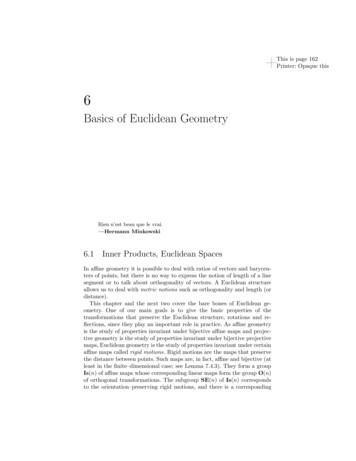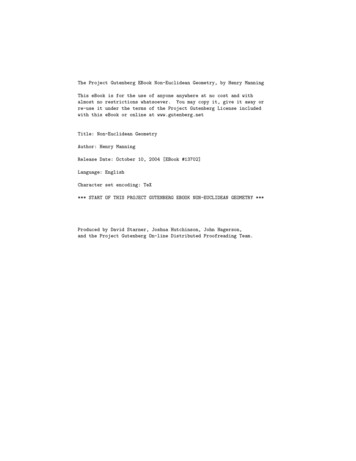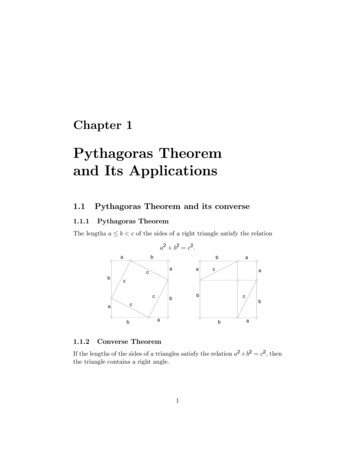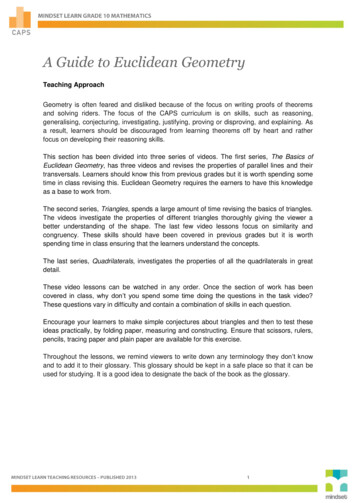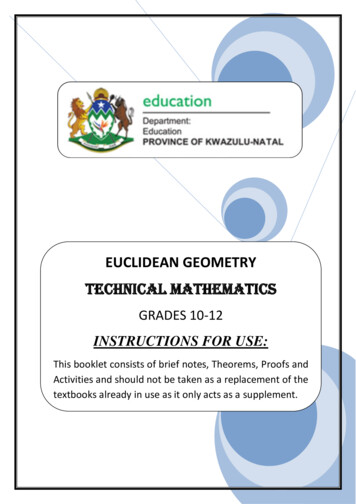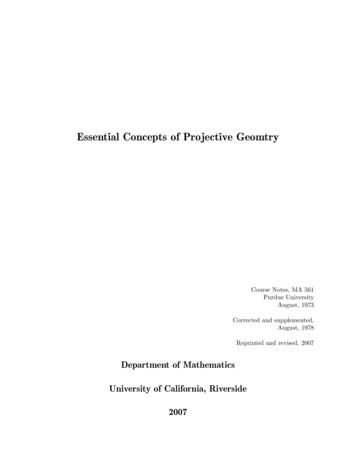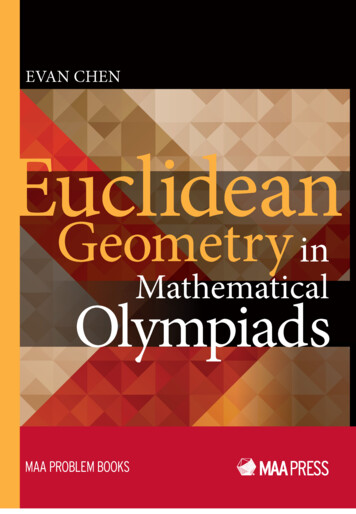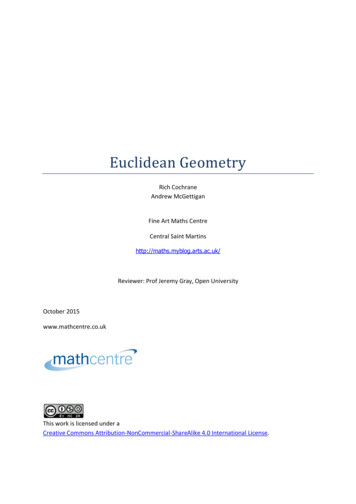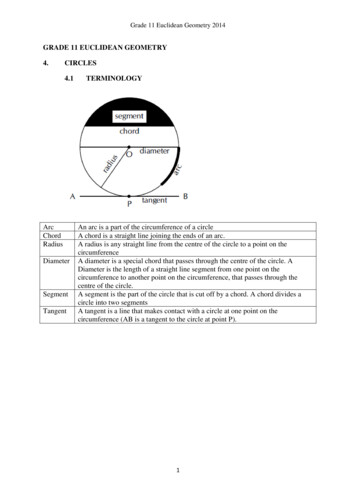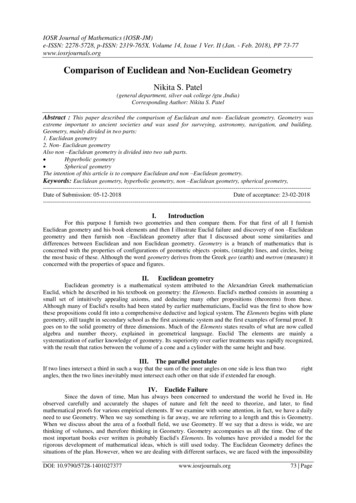
Transcription
IOSR Journal of Mathematics (IOSR-JM)e-ISSN: 2278-5728, p-ISSN: 2319-765X. Volume 14, Issue 1 Ver. II (Jan. - Feb. 2018), PP 73-77www.iosrjournals.orgComparison of Euclidean and Non-Euclidean GeometryNikita S. Patel(general department, silver oak college /gtu ,India)Corresponding Author: Nikita S. PatelAbstract : This paper described the comparison of Euclidean and non- Euclidean geometry. Geometry wasextreme important to ancient societies and was used for surveying, astronomy, navigation, and building.Geometry, mainly divided in two parts:1. Euclidean geometry2. Non- Euclidean geometryAlso non –Euclidean geometry is divided into two sub parts. Hyperbolic geometry Spherical geometryThe intention of this article is to compare Euclidean and non –Euclidean geometry.Keywords: Euclidean geometry, hyperbolic geometry, non –Euclidean geometry, spherical -------------------------------------------Date of Submission: 05-12-2018Date of acceptance: roductionFor this purpose I furnish two geometries and then compare them. For that first of all I furnishEuclidean geometry and his book elements and then I illustrate Euclid failure and discovery of non –Euclideangeometry and then furnish non –Euclidean geometry after that I discussed about some similarities anddifferences between Euclidean and non Euclidean geometry. Geometry is a branch of mathematics that isconcerned with the properties of configurations of geometric objects -points, (straight) lines, and circles, beingthe most basic of these. Although the word geometry derives from the Greek geo (earth) and metron (measure) itconcerned with the properties of space and figures.II.Euclidean geometryEuclidean geometry is a mathematical system attributed to the Alexandrian Greek mathematicianEuclid, which he described in his textbook on geometry: the Elements. Euclid's method consists in assuming asmall set of intuitively appealing axioms, and deducing many other propositions (theorems) from these.Although many of Euclid's results had been stated by earlier mathematicians, Euclid was the first to show howthese propositions could fit into a comprehensive deductive and logical system. The Elements begins with planegeometry, still taught in secondary school as the first axiomatic system and the first examples of formal proof. Itgoes on to the solid geometry of three dimensions. Much of the Elements states results of what are now calledalgebra and number theory, explained in geometrical language. Euclid The elements are mainly asystematization of earlier knowledge of geometry. Its superiority over earlier treatments was rapidly recognized,with the result that ratios between the volume of a cone and a cylinder with the same height and base.III.The parallel postulateIf two lines intersect a third in such a way that the sum of the inner angles on one side is less than twoangles, then the two lines inevitably must intersect each other on that side if extended far enough.IV.rightEuclide FailureSince the dawn of time, Man has always been concerned to understand the world he lived in. Heobserved carefully and accurately the shapes of nature and felt the need to theorize, and later, to findmathematical proofs for various empirical elements. If we examine with some attention, in fact, we have a dailyneed to use Geometry. When we say something is far away, we are referring to a length and this is Geometry.When we discuss about the area of a football field, we use Geometry. If we say that a dress is wide, we arethinking of volumes, and therefore thinking in Geometry. Geometry accompanies us all the time. One of themost important books ever written is probably Euclid's Elements. Its volumes have provided a model for therigorous development of mathematical ideas, which is still used today. The Euclidean Geometry defines thesituations of the plan. However, when we are dealing with different surfaces, we are faced with the impossibilityDOI: 10.9790/5728-1401027377www.iosrjournals.org73 Page
Comparison of Euclidean and Non-euclidean geometryof solving problems through the same geometry. Unlike what happens with the initial four postulates of Euclid,the Fifth Postulate, the famous Parallel Postulate, revealed a lack intuitive appeal, and several were themathematicians who, throughout history, tried to show it. Many retreate before the findings that this would beuntrue; some had the courage and determination to make such a falsehood, thus opening new doors toGeometry. One puts up, then, two questions. Where can be found the clear concepts of such Geometries? Andhow important is the knowledge and study of Geometries, beyond the Euclidean, to a better understanding of theworld around us? The study, now developed, seeks to answer these questions.Since the primary objective is a response to these earlier questions, this study is divided into threephases. The first phase focuses on the historical evolution of Geometry, from its beginnings to the work of theGreek Euclid. In a second phase, the main precursors of Geometry are presented and, subsequently, thediscoverers of Non-Euclidean Geometries, the Elliptic and Hyperbolic Geometries themselves, being the mostoutstanding among all the Non-Euclidean, and even some models of its representations. The third and finalphase is related to the analysis of the presence of Non-Euclidean Geometries in Art and in the Real, the study ofGeometry in Secondary Education and Non-Euclidean Geometries in Higher Education, ending up with somephilosophical implications that one understands be relevant, given all the controversy generated around theseNon-Euclidean theories of Geometry.V.The Forerunners of Non-Euclidean Geometries(The fifth postulate of Euclidean geometry)Several mathematicians tried to prove the correctness of Euclid‟s 5th Postulate for a long time.Although they could get close to real conclusions, they failed, as its primary objective was to prove thePostulate, and not conclude that this could be false (Saccheri, Legendre, Farkas Bolyai, Gauss). Moreover, evenwith assurances regarding their results, the fear of facing the mathematical community, and the shame of beingmarginalized by their act of courage, always stopped them from publishing such findings. As Greenberg said, itis delightfully instructive to observe the mistakes made by capable people as they struggled with the strangepossibility that they or their culture might not accept their conclusions. , but it was finally shown to beimpossible .Postulate 5, the Parallel Postulate If a straight line meets two straight lines, so as to make the twointerior angles on the same side of it taken together less than two right angles, these straight lines, beingcontinuously produced, shall at length meet on the Alternative, but equivalent, version of the Parallel PostulateGiven a line l and a point P not on l, there is only one line m containing P such that l m. These alternativeversions the most commonly used version, but there are several others. It is interesting that one of the otherequivalent versions is the statement that “the sum of the angles in a triangle is 180 ”.We prove this as a theorem, and the Alternative version of the Parallel Postulate will be a veryimportant piece of the proof. They are equivalent because if you started with the “the sum of angles in triangle is180 ” you could prove the parallel postulate. All theorems whose proofs relyon the Parallel Postulate, plus theAbsolute Geometry theorems, are what is known as Euclidean Geometry or Flat Geometry.Euclid's famous treatise, the Elements, was most probably a summary of side on which are the angles that areless than two right angle what was known about geometry in his time, rather than being his original work. In it,he sets out five geometric "postulates", the fifth of which is this:If a straight line falling on two straight lines make the interior angles on the same side less than two right angles,the two straight lines, if produced indefinitely, meet on that side on which are the angles less than the two rightangles.VI.Discovery of non-Euclidean geometryThe beginning of the 19th century would finally witness decisive steps inthe creation of non-Euclidean geometry. Circa 1813, Carl Friedrich Gauss and independently around 1818, theGerman professor of law Ferdinand Karl Schweikart had the germinal ideas of non-Euclidean geometry workedout, but neither published any results. Then, around 1830, the Hungarian mathematician János Bolyai and theRussian mathematician Nikolai Ivanovich Lobachevsky separately published treatises on hyperbolic geometry.Consequently, hyperbolic geometry is called Bolyai-Lobachevskian geometry, as both mathematicians,independent of each other, are the basic authors of non-Euclidean geometry. Gauss mentioned to Bolyai's father,when shown the younger Bolyai's work, that he had developed such a geometry several years before,[10] thoughhe did not publish. While Lobachevsky created a non-Euclidean geometry by negating the parallel postulate,Bolyai worked out a geometry where both the Euclidean and the hyperbolic geometry are possible depending ona parameter k. Bolyai ends his work by mentioning that it is not possible to decide through mathematicalreasoning alone if the geometry of the physical universe is Euclidean or non-Euclidean; this is a task for thephysical sciences.Bernhard Riemann, in a famous lecture in 1854, founded the field of Riemannian geometry, discussing inparticular the ideas now called manifolds, Riemannian metric, and curvature. He constructed an infinite familyDOI: 10.9790/5728-1401027377www.iosrjournals.org74 Page
Comparison of Euclidean and Non-euclidean geometryof geometries which are not Euclidean by giving a formula for a family of Riemannian metrics on the unit ballin Euclidean space. The simplest of these is called elliptic geometry and it is considered to be a non-Euclideangeometry due to its lack of parallel lines. By formulating the geometry in terms of a curvature tensor, Riemannallowed non-Euclidean geometry to be applied to higher dimensionsVII. Axiomatic basis of non-Euclidean geometryEuclidean geometry can be axiomatically described in several ways.Unfortunately, Euclid's original system of five postulates (axioms) is not one of these as his proofs relied onseveral unstated assumptions which should also have been taken as axioms. Hilbert's system consisting of 20axioms most closely follows the approach of Euclid and provides the justification for all of Euclid's proofs.Other systems, using different sets of undefined terms obtain the same geometry by different paths. In allapproaches, however, there is an axiom which is logically equivalent toEuclid's fifth postulate, the parallel postulate. Hilbert uses the Playfair axiom form, while Birkhoff, for instance,uses the axiom which says that"there exists a pair of similar but not congruent triangles."In any of these systems, removal of the one axiom which is equivalent to the parallel postulate, in whateverform it takes, and leaving all the other axioms intact, produces absolute geometry. As the first 28 propositions ofEuclid (in The Elements) do not require the use of the parallel postulate or anything equivalent to it, they are alltrue statements in absolute geometry. axiom form, since it is a compound statement (. there exists one and onlyone .), can be done in two ways. Either there will exist more than one line through the point parallel to thegiven line or there will exist no lines through the point parallel to the given line. In the first case, replacing theparallel postulate (or its equivalent) with the statement "In a plane, given a point P and a line ℓ not passingthrough P, there exist two lines through P which do not meet ℓ" and keeping all the other axioms, yieldshyperbolic geometry. The second case is not dealt with as easily. Simply replacing the parallel postulate with thestatement, "In a plane, given a point P and a line ℓ not passing through P, all the lines through P meet ℓ", doesnot give a consistent set of axioms. This follows since parallel lines exist in absolute geometry, but thisstatement says that there are no parallel lines. This problem was known (in a different guise) to Khayyam,Saccheri and Lambert and was the basis for their rejecting what was known as the "obtuse angle case". In orderto obtain aconsistent set of axioms which includes this axiom about having no parallel lines, some of the other axiomsmust be tweaked. The adjustments to be made depend upon the axiom system being used. Among others thesetweaks will have the effect of modifying Euclid's second postulate from the statement that line segments can beextended indefinitely to the statement that lines are unbounded. Riemann's elliptic geometry emerges as themost natural geometry satisfying this axiom.To obtain a non-Euclidean geometry, the parallel postulate (or its equivalent) must be replaced by itsnegation. Negating the Playfair's axiom form, since it is a compound statement (.there exists one and only one.), can be done in two ways. Either there will exist more than one line through the point parallel to the givenline or there will exist no lines through the point parallel to the given line. In the first case, replacing the parallelpostulate (or its equivalent) with the statement "In a plane, given a point P and a line ℓ not passing through P,there exist two lines through P which do not meet ℓ" and keeping all the other axioms, yields hyperbolicgeometry. The second case is not dealt with as easily. Simply replacing the parallel postulate with the statement,"In a plane, given a point P and a line ℓ not passing through P, all the lines through P meet ℓ", does not give aconsistent set of axioms. This follows since parallel lines exist in absolute geometry, but this statement says thatthere are no parallel lines. This problem was known (in a different guise) to Khayyam, Saccheri and Lambertand was the basis for their rejecting what was known as the "obtuse angle case". In order to obtain aconsistent set of axioms which includes this axiom about having no parallel lines, some of the other axiomsmust be tweaked. The adjustments to be made depend upon the axiom system being used. Among others thesetweaks will have the effect of modifying Euclid's second postulate from the statement that line segments can beextended indefinitely to the statement that lines are unbounded. Riemann's elliptic geometry emerges as themost natural geometry satisfying this axiom.1A.B.C.Comparison of Euclidean geometry and non-Euclidean geometryEuclidean geometryParabolic geometrySpherical geometryDOI: 10.9790/5728-1401027377www.iosrjournals.org75 Page
Comparison of Euclidean and Non-euclidean geometryEuclideanParabolic geometryEuclid (300 B.C)Euclidean geometry in thisclassificationisparabolicgeometry, through the name is lessoften used.Euclidean Geometry is what we'refamiliar with on a day to day basisand follows Euclid's Parallelpostulate; given a Straight Lineand a Point not on that Line, thereis only one Line you can draw thatpasses through that Point AND isparallel to the first Line.Non- EuclideanHyperbolic geometryLobatchevski , Bloyai (1830)The negatively curved non-Euclidean geometryis called hyperbolic geometryEuclidean geometry is flat so itscurvature is zero.5th axiom/parallel axiom: given astraight line and a point not on theline, there exists one and only onestraight line through the piointwhich is parallel to the originalline.The sum of the angles of a triangleis180degrees.Negatively curvedPositively curvedGiven a straight line and a point not on the line.there exists an infinite number of straight linesthrough the point parellal to the original line.Given a straight line and the point noton the line, there are no straight linesthrough the point parallel to theoriginal line.The sum of the angles of a triangle is less than180The sum of the angles of a triangle isalways greater than 180 degrees.Hyperbolic Geometry can be derived from theanswer to Saccheri's Quadrilateral where thetwo remaining angles are smaller than 90degrees. It's typically only used to very highlevel math and physics and some models of theuniverse revolve around the use of HyperbolicGeometry. This leads to a variation of Euclid'sParallel Postulate, and in Hyperbolic Geometrythis new version states; given a Straight Lineand a Point not on that Line, there are at leasttwo lines parallel to the initial Line.Spherical geometryG .F .B .Riemann (1850)Spherical geometry is called ellipticalgeometry, but the space of ellipticgeometry is really has points antipodal pairs on the sphere.Elliptic Geometry is derived from thelast answer to Saccheri's Quadrilateralwhere the two remaining angles arelarger than 90 degrees. UnlikeHyperbolicGeometry,EllipticGeometry is widely used by pilots andship captains because it describes theGeometry on the surfaces of Spheres.Similar to Euclidean and HyperbolicGeometries, it too has it's ownvariation on the original ParallelPostulate which states; given a StraightLine and a Point not on that Line, thereare no lines parallel to the initial Line.degreesGeometry Is on plane:Geometry is on a pseudo sphere:Geometry is on a sphere:In Euclidean geometry, given apoint and a line, there is exactlyone line through the point that is inthe same plane as the given lineIn hyperbolic geometry there are at least twodistinct lines that passes through the point andare parallel to (in the same plane as and do notintersect) the given line.In spherical geometry there are no suchlines.DOI: 10.9790/5728-1401027377www.iosrjournals.org76 Page
Comparison of Euclidean and Non-euclidean geometryand never intersects it.Definition of a line is “breadth lesslength” and a straight line being aline “which lies evenly with thepoints on itself”.Lines are defined such that the shortestdistance between two points lies alongthem. Lines in spherical geometry aregreat circles. A great circle is thelargest circle that can be drawn on asphere. Great circles are lines thatdivide a sphere into two equal.If two lines are parallel to a thirdline, then the two lines are parallelto each other.If two lines are parallel then, twolines are equidistant.Lines that do not have an end(infinite lines),also do not have aboundary (a point that they areheaded toward, yet never reach)Euclidean geometry is geometryon a plane(like the surface of apiece of paper), and deals withpoints and linesThis is false in hyperbolic geometry.In Euclidean geometry.In non-Euclidean geometry. . .is a triangle. .is a triangleeuclidean geometry deals withmore structured mathematics, suchas triangles.Euclidean geometry has 1 parallelline through any given point noton a lineEuclidean geometry is hold in twodimensions.Euclidean geometry is used insurveying and buildingThis is false in hyperbolic geometry.This is false in hyperbolic geometry.Non Euclidean geometry are on a sphere.Hyperbolic geometry is associated with „curved‟spacewhile non euclidean geometry has more abstractshapes, ones with no describable, or permanentnameHyperbolic geometry has at least 2 parallel linesSpherical geometry is plane geometryon the surface of a sphere. So a straightline on the surface of a sphere wouldbecome an arc, and the longest linewould equate to the diameter of thesphere.Spherical geometry has no parallellinesHold in two and three dimension.Hold in two and three dimensionA modern use of Hyperbolic geometry is in thetheory of special Relativity ,particularlyminskowski space time ,and gyro vector spaceConcepts of spherical geometry mayalso be applied to the oblong sphere,though minor modifications must beimplemented on certain formulas.Two practical application of theprincipal of spherical geometry are tonavigation and astronomyIt has simple trigonometryIt has spherical o.com/question/index?qid p://www.cs.unm.edu/ edu/ etween-euclidean-and-non-euclidean-geometry/Nikita S. Patel " Comparison of Euclidean and Non-Euclidean Geometry " IOSR Journal ofMathematics (IOSR-JM) 14.1 (2018): 73-77.DOI: 10.9790/5728-1401027377www.iosrjournals.org77 Page
DOI: 10.9790/5728-1401027377 www.iosrjournals.org 75 Page of geometries which are not Euclidean by giving a formula for a family of Riemannian metrics on the unit ball in Euclidean space. The simplest of these is called elliptic geometry and it is considered to be a non-Euclidean geometry due to its lack of parallel lines. By formulating the geometry in terms of a curvature tensor, Riemann .


